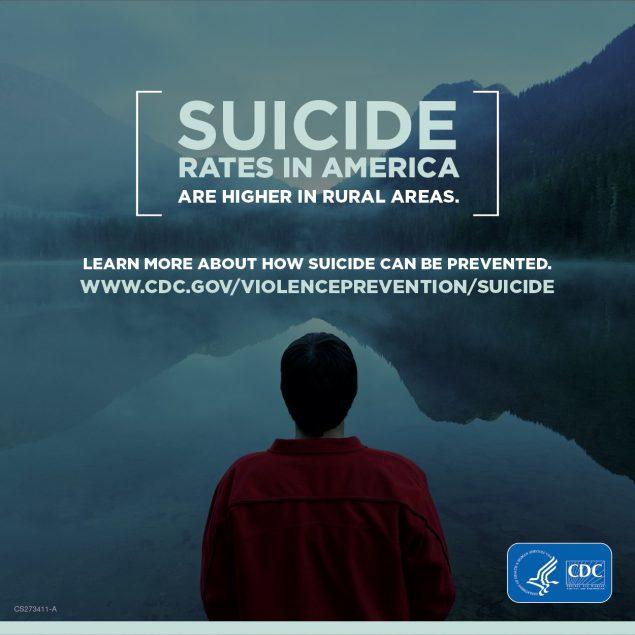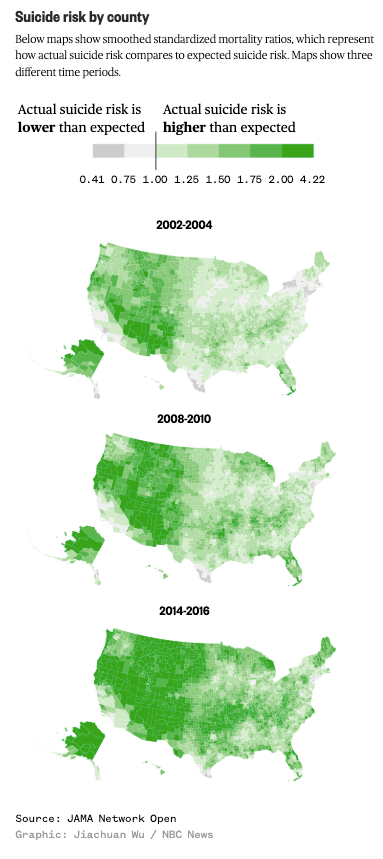A new study published last week sounds the alarm on a suicide crisis that is crushing rural America.
From 1999 to 2016, the suicide rate of Americans ages 25 to 64 jumped 41%, researchers noted in JAMA Network Open. The study found Americans living in rural communities had a 25% higher probability of taking their own life than those in cities.
The study, Contextual Factors Associated With County-Level Suicide Rates in the United States, 1999 to 2016, was led by Danielle Steelesmith, a postdoctoral fellow at Ohio State University’s Wexner Medical Center, said suicide rates have been increasing in rural America thanks to increasing poverty, low incomes, farming bust, deindustrialization, and vast amounts of underemployment.
“Those factors are really bad in rural areas,” said Steelesmith.
Steelesmith said from 1999 to 2016, there were 453,577 suicides among Americans ages 25 to 64, with the most significant amount occurring after 2010 through 2016. About 350,000 of the deaths were male, and many were middle-aged adults.
The highest observed suicide rates were in the West, including in Colorado, New Mexico, Utah, and Wyoming; Appalachia, including counties in Kentucky, Virginia, West Virginia; and the Ozarks, including counties in Arkansas and Missouri.
“Long-term and persistent poverty appears to be more entrenched and economic opportunities more constrained in rural areas. Greater social isolation, challenges related to transportation and interpersonal communication, and associated difficulties accessing health and mental health services likely contribute to the disproportionate association of deprivation with suicide in rural counties,” Steelesmith said.
The study’s social fragmentation index includes levels of single-person households, unmarried residents, and resident impermanence. High social fragmentation was associated with counties with higher suicide rates.
With the availability of guns at Walmart and the proliferation of gun shops across the Central and Midwest states over the last two decades, access to firearms in rural communities has notably driven up suicides.
Oren Miron, a researcher at the Clalit Research Institute in Israel, said the jump in suicide rates in rural counties is “alarming.”
Miron wasn’t involved in the study but said the primary factor for high suicide rates was unemployment.
Suicide “is a growing American tragedy,” Dr. Albert Wu, an internist and a professor of health policy and management at the Johns Hopkins Bloomberg School of Public Health.
“It has become a leading cause of death in the U.S., and is a major public health problem.”
In rural communities, “many of the most pernicious health and social problems intersect,” Wu said.
Lack of health care and mental health facilities in rural areas further compounds the problem. “Insurance can be a proxy for people’s access to mental health care,” Steelesmith said.
Wu agreed. “Lack of health insurance kills people,” he said. “More insurance, including the expansion of Medicaid, could help.”
Still, “the social determinants of health are really important,” said Dr. David Brent, the endowed chair in suicide studies and a professor of psychiatry at the University of Pittsburgh. “You can’t make a dent in these kinds of public health problems without doing something to deal with [those social determinants]. Yes, you can provide more services to impoverished people, but there’s nothing like helping people get out of poverty.”
And since the study only examined 1999-2016 suicide data, it’s likely that suicides in rural America from 2016 to present have increased, thanks to a farming bust and a manufacturing recession.
The Emergency Election Sale is now live! Get 30% to 60% off our most popular products today!




